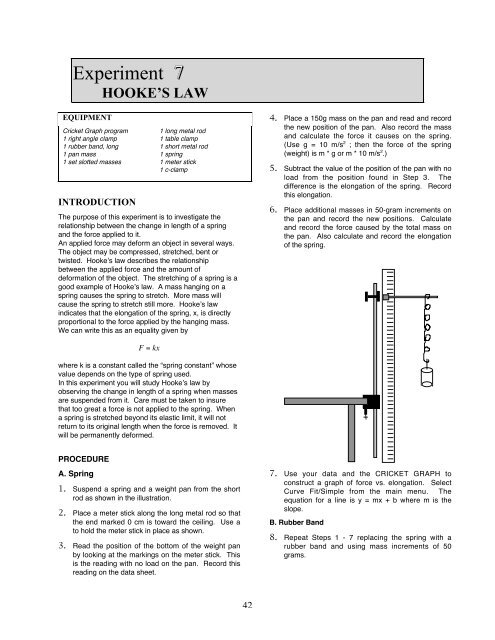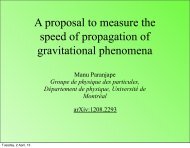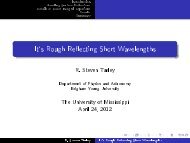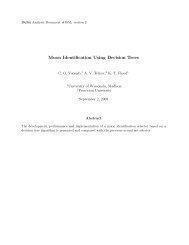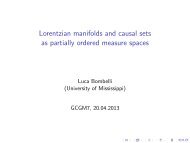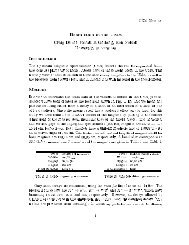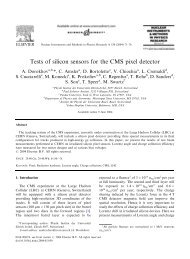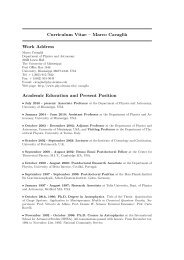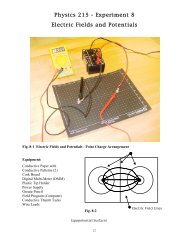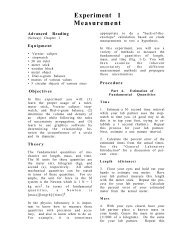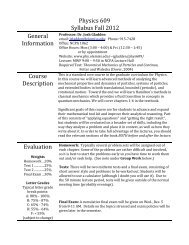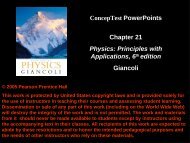Hooke's Law.
Hooke's Law.
Hooke's Law.
Create successful ePaper yourself
Turn your PDF publications into a flip-book with our unique Google optimized e-Paper software.
Experiment 7<br />
HOOKE’S LAW<br />
EQUIPMENT<br />
Cricket Graph program<br />
1 right angle clamp<br />
1 rubber band, long<br />
1 pan mass<br />
1 set slotted masses<br />
INTRODUCTION<br />
1 long metal rod<br />
1 table clamp<br />
1 short metal rod<br />
1 spring<br />
1 meter stick<br />
1 c-clamp<br />
The purpose of this experiment is to investigate the<br />
relationship between the change in length of a spring<br />
and the force applied to it.<br />
An applied force may deform an object in several ways.<br />
The object may be compressed, stretched, bent or<br />
twisted. Hooke’s law describes the relationship<br />
between the applied force and the amount of<br />
deformation of the object. The stretching of a spring is a<br />
good example of Hooke’s law. A mass hanging on a<br />
spring causes the spring to stretch. More mass will<br />
cause the spring to stretch still more. Hooke’s law<br />
indicates that the elongation of the spring, x, is directly<br />
proportional to the force applied by the hanging mass.<br />
We can write this as an equality given by<br />
4. Place a 150g mass on the pan and read and record<br />
the new position of the pan. Also record the mass<br />
and calculate the force it causes on the spring.<br />
(Use g = 10 m/s 2 ; then the force of the spring<br />
(weight) is m * g or m * 10 m/s 2 .)<br />
5. Subtract the value of the position of the pan with no<br />
load from the position found in Step 3. The<br />
difference is the elongation of the spring. Record<br />
this elongation.<br />
6. Place additional masses in 50-gram increments on<br />
the pan and record the new positions. Calculate<br />
and record the force caused by the total mass on<br />
the pan. Also calculate and record the elongation<br />
of the spring.<br />
F = kx<br />
where k is a constant called the “spring constant” whose<br />
value depends on the type of spring used.<br />
In this experiment you will study Hooke’s law by<br />
observing the change in length of a spring when masses<br />
are suspended from it. Care must be taken to insure<br />
that too great a force is not applied to the spring. When<br />
a spring is stretched beyond its elastic limit, it will not<br />
return to its original length when the force is removed. It<br />
will be permanently deformed.<br />
PROCEDURE<br />
A. Spring<br />
1. Suspend a spring and a weight pan from the short<br />
rod as shown in the illustration.<br />
2. Place a meter stick along the long metal rod so that<br />
the end marked 0 cm is toward the ceiling. Use a<br />
to hold the meter stick in place as shown.<br />
3. Read the position of the bottom of the weight pan<br />
by looking at the markings on the meter stick. This<br />
is the reading with no load on the pan. Record this<br />
reading on the data sheet.<br />
7. Use your data and the CRICKET GRAPH to<br />
construct a graph of force vs. elongation. Select<br />
Curve Fit/Simple from the main menu. The<br />
equation for a line is y = mx + b where m is the<br />
slope.<br />
B. Rubber Band<br />
8. Repeat Steps 1 - 7 replacing the spring with a<br />
rubber band and using mass increments of 50<br />
grams.<br />
42
Experiment 7<br />
DATA SHEET<br />
Name: __________________________<br />
Section: ________________________<br />
Elastic Spring<br />
Reading with no load __________ (cm)<br />
Mass<br />
(g)<br />
Mass on spring<br />
(kg)<br />
Force on<br />
spring<br />
(N)<br />
Reading with<br />
load<br />
(cm)<br />
Elongation<br />
of spring<br />
(cm)<br />
0 0 0 0<br />
150<br />
200<br />
250<br />
300<br />
350<br />
400<br />
450<br />
500<br />
QUESTIONS (Answer on back of Data Sheet)<br />
1. What is the relationship between the elongation of the spring and the weight attached to the spring? How does your<br />
graph support or refute your answer?<br />
2. What is the spring constant for your spring?<br />
3. Looking at your graph for the spring, what do you predict to be the elongation of your spring when loaded with a<br />
weight of 0.2, 2.0, and 4.0 newtons?<br />
44
Experiment 7<br />
DATA SHEET<br />
Rubber Band<br />
Reading with no load __________ (cm)<br />
Mass<br />
(g)<br />
Mass on spring<br />
(kg)<br />
Force on<br />
spring<br />
(N)<br />
Reading with<br />
load<br />
(cm)<br />
Elongation<br />
of spring<br />
(cm)<br />
0 0 0 0<br />
150<br />
200<br />
250<br />
300<br />
350<br />
400<br />
450<br />
500<br />
QUESTIONS (Answer on back of Data Sheet)<br />
4. Was the graph of elongation versus force for the rubber band a straight line? In other words, is the<br />
elongation of your rubber band proportional to the force exerted? If not, then it doesn’t follow Hooke’s<br />
law; state a reason why.<br />
5. Can you find a “spring constant” for the rubber band? If not, why?<br />
6. What would finally happen to the spring if you continue to add additional weights to the spring? What<br />
do we call this effect? And to the rubber band?<br />
44


